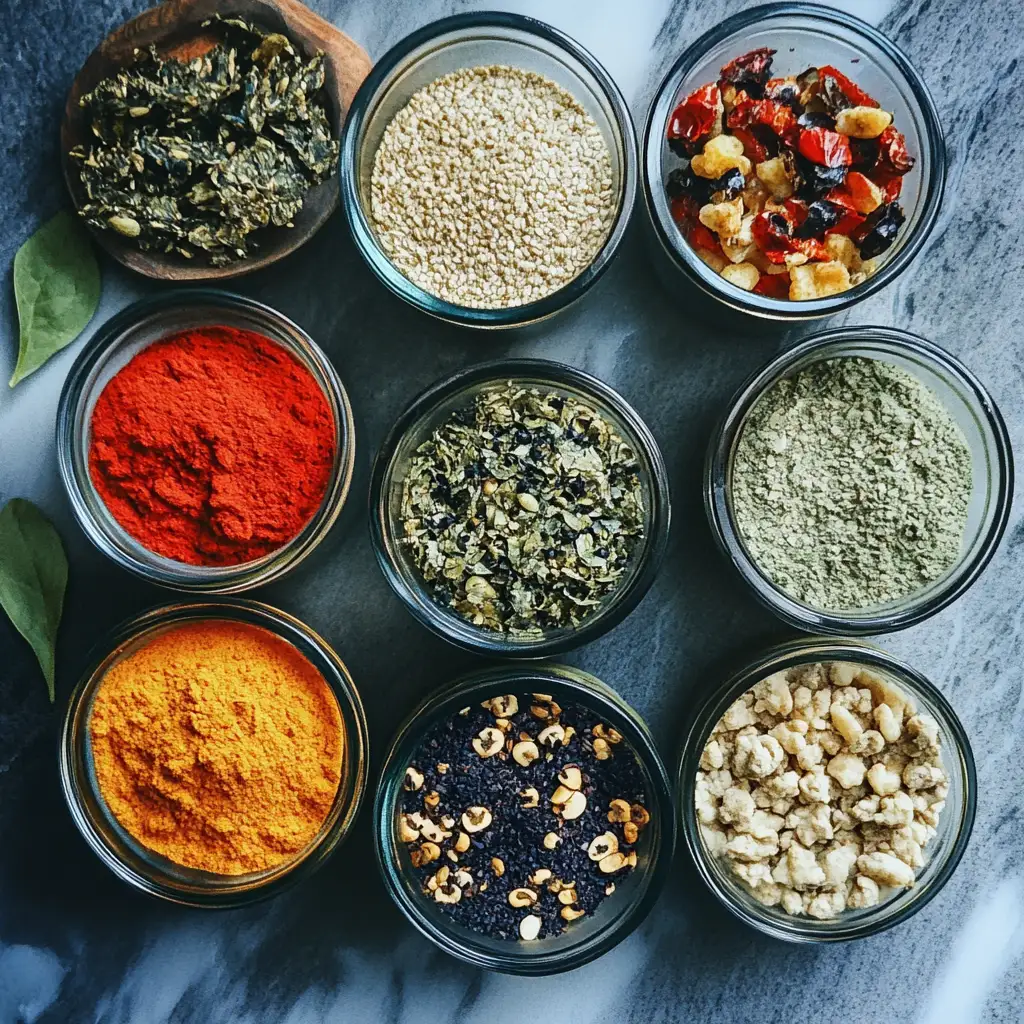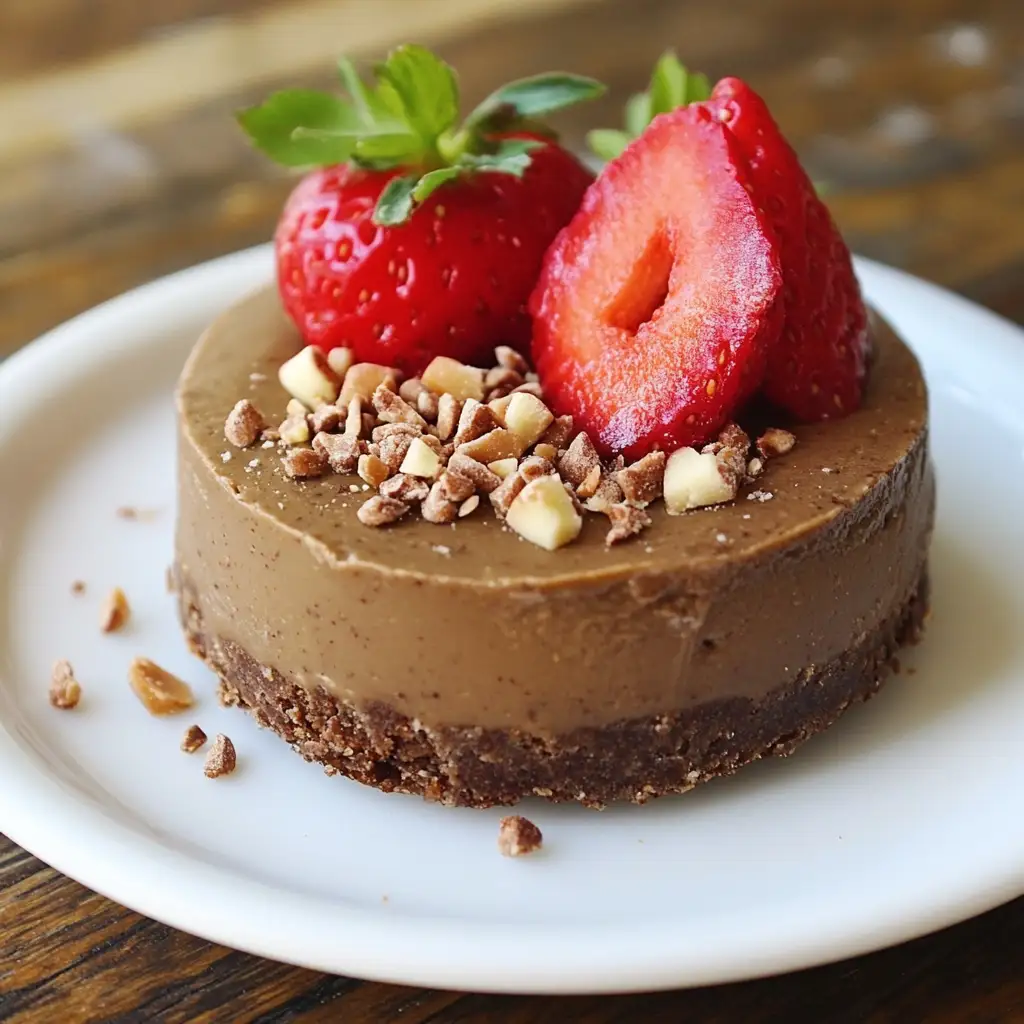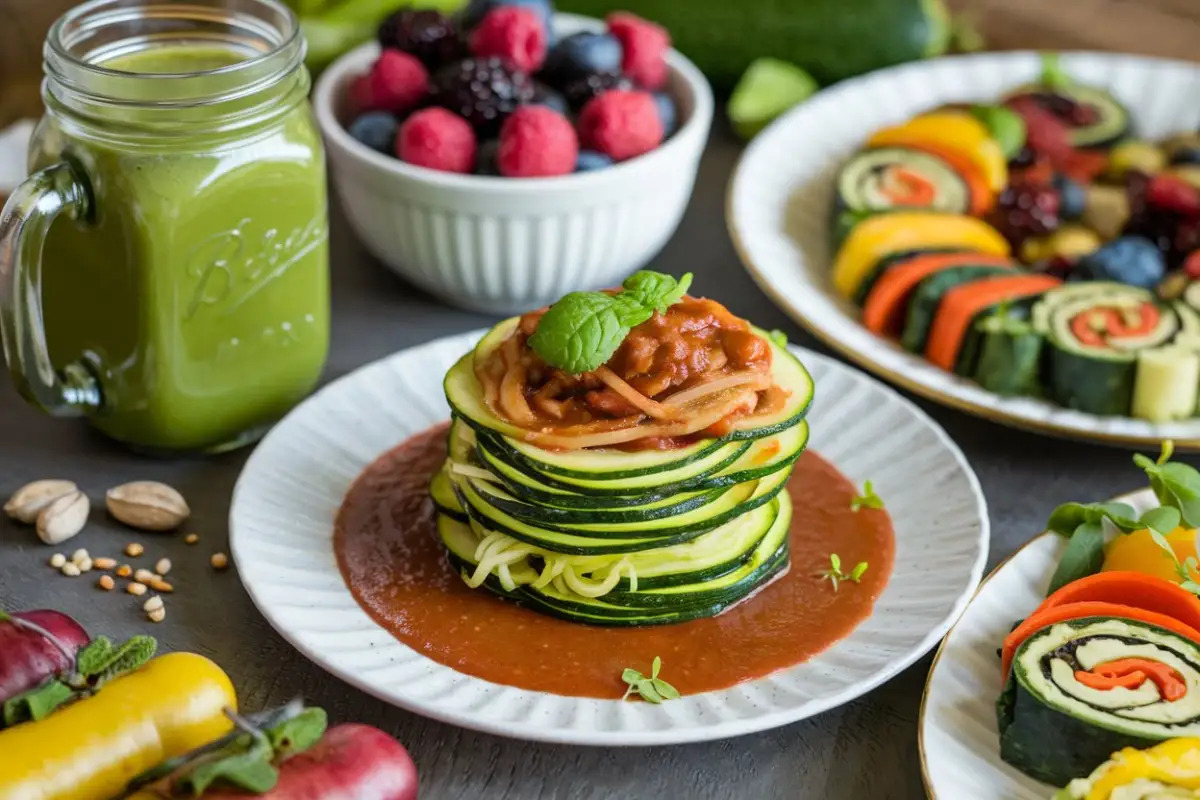Are you curious about raw vegan recipes but not quite sure where to start? Perhaps you’ve heard about the incredible health benefits, or maybe you’re just looking to add something fresh and exciting to your meal plan (without the actual “spice” of cooking). Whatever it is that brought you here, you’re in for a treat—literally! In fact, the world of raw vegan cuisine is full of vibrant flavors, surprising textures, and nutritious goodness. So, let’s dive right in, uncover its secrets, and discover how to create mouthwatering dishes that are as great for your body as they are for your taste buds.
What Are Raw Vegan Recipes?
If you’re wondering what exactly makes a recipe “raw” and “vegan,” it’s primarily about simplicity and staying true to nature. Essentially, a raw vegan diet focuses on plant-based foods that are not heated above 118°F (48°C). But why the temperature limit? This is because it’s believed that cooking at higher temperatures can destroy essential enzymes and nutrients, thereby making the food less beneficial for your body.
Think of it like this: raw vegan food is, after all, Mother Nature’s way of saying, “Hey, keep it simple!” In other words, it’s all about preserving the natural goodness of fruits, veggies, nuts, seeds, and more.
Understanding the Raw Vegan Diet
At its core, the raw vegan lifestyle is fundamentally about embracing whole, unprocessed foods. In fact, you won’t find anything artificial here—just pure, nutrient-packed ingredients. While some people choose to go raw vegan for the health benefits, others do so for ethical or environmental reasons. Either way, it’s a lifestyle that not only focuses on nourishing your body but also benefits the planet.
Does this mean you’re stuck eating salads 24/7? Not at all! From creamy cashew-based “cheese” to decadent raw chocolate desserts, the possibilities are endless.
Key Principles of Raw Food Preparation
So, what’s the trick to creating delicious raw meals? It’s all about:
- Balancing flavors: Think sweet, salty, sour, and umami.
- Texture variety: Crunchy, creamy, chewy—you can have it all.
- Freshness: Always choose ripe, high-quality produce.
Here’s a pro tip: Get creative with spices, herbs, and natural sweeteners like dates or maple syrup (raw, of course). These ingredients are your best friends when it comes to crafting flavorful dishes.
Benefits of Raw Vegan Recipes
Why are so many people ditching their stovetops and diving into raw veganism? Let’s break down the benefits:
Health Benefits of Going Raw Vegan
Imagine feeling energized, sleeping better, and even glowing from the inside out. That’s what many raw vegans report! Some key health perks include:
- Improved digestion: All those enzymes help your tummy do its job.
- Increased nutrient intake: Vitamins and minerals stay intact without heat.
- Natural detoxification: Your body gets a break from processed junk.
Of course, results may vary. But if you’re looking to hit the reset button on your health, raw veganism is worth a try.
Environmental and Ethical Advantages
Eating raw isn’t just good for you—it’s good for the planet. Think about it: no processed foods mean less packaging waste. Plus, a plant-based diet significantly reduces your carbon footprint.
Ethically, it aligns with a cruelty-free lifestyle. By focusing on plant-based ingredients, you’re supporting a more compassionate food system.
Weight Management and Energy Boosting
One of the most noticeable changes when you go raw? The extra pep in your step! Since raw vegan recipes are naturally low in unhealthy fats and sugars, they can help with weight management. Plus, the high fiber content keeps you full and satisfied.
Feel like your energy is lagging after lunch? Try swapping your cooked meals for raw ones, and you might just skip that afternoon slump altogether.
Essential Ingredients for Raw Vegan Recipes

Before you roll up your sleeves (or maybe your kale leaves), let’s talk about what you’ll need to stock up on.
Staples for a Raw Vegan Pantry
A solid raw vegan pantry starts with the basics:
- Nuts and seeds: Almonds, cashews, chia seeds, and hemp seeds.
- Dried fruits: Dates, raisins, and goji berries are great natural sweeteners.
- Plant-based oils: Think cold-pressed olive oil or coconut oil.
These ingredients form the foundation for everything from creamy dressings to decadent desserts.
Seasonal Produce Selection
The true beauty of raw veganism lies in its emphasis on fresh, seasonal ingredients. For instance, in the summer, you can enjoy refreshing options like watermelon and cucumbers. Meanwhile, in the winter, it’s a great time to stock up on citrus fruits and hearty greens.
Shopping at your local farmer’s market can be a game-changer for both freshness and flavor. Plus, it’s a great way to support your community!
Superfoods to Enhance Your Raw Recipes
Superfoods are like the cherry on top of your raw vegan sundae. Add these powerhouses for an extra nutrient boost:
- Spirulina: A vibrant green algae packed with protein.
- Cacao: Raw chocolate that’s rich in antioxidants.
- Maca powder: Great for energy and hormone balance.
H2: Tools and Equipment for Raw Vegan Cooking
Before diving into raw vegan recipes, let’s talk tools. Having the right equipment can make raw food preparation a breeze. Don’t worry; you won’t need a fancy chef’s kitchen—just a few essentials to get started.
Must-Have Kitchen Tools for Beginners
Starting raw vegan doesn’t require a complete kitchen overhaul. Here’s what you’ll need to begin your culinary journey:
- High-Quality Knife and Cutting Board: These are your bread and butter (or should I say kale and avocado?) for prepping fresh produce.
- Blender: A powerful blender is essential for making smoothies, soups, and sauces. Look for one that can handle nuts for creamy dressings.
- Spiralizer: Craving pasta? Use a spiralizer to turn zucchini or carrots into noodle-like strands.
- Mason Jars: Perfect for storing dressings, smoothies, or fermented foods.
Advanced Appliances for Raw Food Enthusiasts
If you’re ready to level up, these tools can take your raw vegan game to the next level:
- Dehydrator: This is a must for making raw crackers, fruit leathers, or even veggie chips.
- Food Processor: Great for chopping, blending, or creating raw doughs and spreads.
- Juicer: Freshly pressed juices are a raw vegan staple, offering a quick nutrient boost.
- Mandoline Slicer: Perfect for creating uniform slices for salads and garnishes.
Investing in these appliances can open up endless possibilities, making your raw vegan kitchen as versatile as a Swiss Army knife.
Common Challenges in Raw Vegan Cooking and Solutions
Every journey, of course, comes with bumps in the road, and raw veganism is certainly no exception. Therefore, let’s take a closer look at some of the most common challenges you might face—and, more importantly, how to overcome them.
Difficulty Finding Ingredients
Living in a smaller town or having limited grocery options? Don’t sweat it. Here’s how to work around this:
- Shop online: Websites specializing in raw ingredients can deliver straight to your door.
- Local markets: Visit farmer’s markets for fresh, seasonal produce.
- Substitutions: Can’t find cashews for a recipe? Try sunflower seeds or macadamia nuts instead.
Time-Consuming Preparation Methods
Yes, raw vegan recipes can be labor-intensive, but they don’t have to be. Simplify with these tips:
- Batch Prep: Chop veggies and make sauces ahead of time for quick assembly during the week.
- Quick Recipes: Start with smoothies, salads, or simple wraps that require minimal prep.
- Invest in Tools: Gadgets like food processors and spiralizers save time.
Think of it as a creative art project—the more you practice, the faster and more enjoyable it becomes!
Maintaining Nutritional Balance
A raw vegan diet is nutrient-packed, but it requires some planning to ensure you’re meeting your body’s needs. Focus on these essentials:
- Protein: Incorporate nuts, seeds, and legumes like sprouted lentils.
- Iron: Dark leafy greens like spinach and kale are excellent sources.
- B12: Consider fortified foods or a supplement to cover this vitamin.
Balancing your meals ensures you feel energized and satisfied, not deprived.
Quick and Easy Raw Vegan Recipes for Beginners
Starting a raw vegan lifestyle, however, doesn’t mean you have to become a gourmet chef overnight. Instead, let’s take a moment to explore some easy-to-make recipes that, in addition, pack a flavorful punch.
Breakfast Ideas: Smoothies, Overnight Chia Pudding
Start your day right with these simple, energizing recipes:
- Green Smoothie:
- Ingredients: Spinach, frozen mango, banana, and almond milk.
- Blend and go! Add chia seeds for extra fiber.
- Overnight Chia Pudding:
- Ingredients: Chia seeds, almond milk, maple syrup, and vanilla.
- Mix in a jar, leave overnight, and top with berries in the morning. Easy-peasy!
Lunch Options: Fresh Salads, Raw Wraps
Midday meals can be light yet filling:
- Rainbow Salad:
- Combine shredded carrots, cabbage, bell peppers, and kale.
- Drizzle with a tahini-lemon dressing for a burst of flavor.
- Raw Veggie Wraps:
- Use collard greens or lettuce as wraps.
- Fill with avocado, cucumber, sprouts, and a dollop of hummus.
These options are perfect for quick lunches that fuel your afternoon.
Gourmet Raw Vegan Recipes for Special Occasions
Who says raw vegan meals can’t be fancy? Special occasions call for dishes that wow the crowd, and raw vegan recipes are no exception. These creations are not only visually stunning but also incredibly satisfying.
Desserts: Raw Cheesecakes, Chocolate Treats

Let’s start with the showstoppers: desserts! These sweet treats are proof that raw vegan food can be indulgent.
- Raw Berry Cheesecake:
- Crust: Blend dates and almonds into a sticky paste, then press into a springform pan.
- Filling: Blend cashews (soaked overnight), coconut cream, maple syrup, and fresh berries until smooth. Pour over the crust and freeze until firm.
- Garnish: Top with fresh fruit for a vibrant finish.
- Raw Chocolate Truffles:
- Ingredients: Blend cacao powder, dates, and almond butter. Roll into bite-sized balls and coat with shredded coconut or crushed nuts.
- Perfect For: Gifting, parties, or just treating yourself after a long day.
Main Dishes: Stuffed Veggies, Raw Pizza
For the main course, bring the wow factor:
- Stuffed Bell Peppers:
- Filling: Combine chopped veggies, sprouted quinoa, and a cashew-based “cheese” sauce.
- Assembly: Stuff the mixture into halved bell peppers and garnish with fresh herbs.
- Raw Pizza:
- Crust: Dehydrate a mixture of flax seeds, almonds, and sun-dried tomatoes into a thin base.
- Toppings: Add raw marinara, fresh veggies, and dollops of cashew cheese.
These dishes are hearty, flavorful, and perfect for impressing guests.
Raw Vegan Meal Planning Tips
Meal planning is the key to staying consistent and enjoying a stress-free raw vegan lifestyle. With a little prep, you’ll never find yourself wondering what to eat.
Planning a Weekly Menu
Start by mapping out your meals for the week. Here’s a simple strategy:
- Breakfast: Smoothies or chia pudding (easy to prepare in advance).
- Lunch: Salads or wraps that can be assembled quickly.
- Dinner: More creative dishes like zucchini pasta or veggie bowls.
- Snacks: Keep raw energy balls or trail mix on hand for when hunger strikes.
Batch prep on Sundays to save time during the week. For example, chop veggies, soak nuts, and blend sauces ahead of time.
Budget-Friendly Raw Vegan Shopping Tips
Worried about the cost? Raw vegan doesn’t have to break the bank. Here’s how to save:
- Buy in Bulk: Stock up on nuts, seeds, and dried fruits from bulk bins.
- Seasonal Produce: Choose fruits and veggies that are in season—they’re cheaper and tastier.
- DIY: Make your own nut milk, granola, or raw snacks instead of buying pre-made options.
Storing and Preserving Raw Vegan Foods
Raw food doesn’t always have the longest shelf life, so proper storage is crucial to avoid waste and keep everything fresh.
Proper Storage Techniques for Fresh Ingredients
- Leafy Greens: Wrap in a damp paper towel and store in the fridge.
- Nuts and Seeds: Keep them in airtight containers in the pantry or fridge to prevent spoilage.
- Fruits: Store bananas, avocados, and tomatoes at room temperature, but refrigerate berries and grapes.
Investing in glass containers or reusable silicone bags can help extend the life of your ingredients.
Dehydration and Fermentation Methods
If you have a dehydrator, it’s a game-changer for preserving raw foods. Make your own:
- Fruit Leathers: Blend fruits, spread onto trays, and dehydrate until leathery.
- Raw Crackers: Mix flax seeds, veggies, and spices, then dehydrate into crispy snacks.
Fermentation is another great way to preserve food. Try making raw sauerkraut or kimchi—they’re loaded with probiotics and add a tangy kick to your meals.
Enhancing Flavors with Natural Seasonings
Seasoning is the secret to elevating your raw dishes. Use:
- Herbs and Spices: Fresh basil, cilantro, cumin, and smoked paprika can transform any dish.
- Acids: A squeeze of lemon or lime juice brightens up flavors instantly.
- Sweeteners: Dates, raw honey, or agave nectar add a natural touch of sweetness.
The Art of Plating and Presentation
We eat with our eyes first, right? Take a little extra time to plate your food beautifully:
- Colors: Use vibrant produce to create a rainbow effect.
- Textures: Add crunch with seeds or a creamy drizzle of cashew sauce.
- Garnishes: Sprinkle fresh herbs or edible flowers for that professional touch.
Frequently Asked Questions About Raw Vegan Recipes
Got questions? You’re not alone! Here are some of the most common concerns and answers.
Can Raw Vegan Diets Provide Enough Protein?
Absolutely! Protein sources include:
- Nuts and seeds (almonds, chia, flax)
- Legumes (sprouted lentils, chickpeas)
- Leafy greens (spinach, kale)
Pairing these throughout the day ensures you meet your protein needs.
How to Transition Smoothly to a Raw Vegan Lifestyle?
Take it one step at a time:
- Start Small: Add one raw meal per day.
- Experiment: Try different recipes to find your favorites.
- Plan Ahead: Keep your pantry stocked with raw essentials.
Remember, it’s about progress, not perfection.
Conclusion: Embrace the Raw Vegan Lifestyle for Health and Vitality
Raw vegan recipes are more than just food—they’re a lifestyle choice that nourishes your body, mind, and the planet. Whether you’re here for the health benefits, ethical reasons, or just to try something new, raw veganism has something for everyone.
So, what are you waiting for? Grab that blender, spiralizer, or mason jar and start creating! Your journey into the colorful, flavorful world of raw vegan food awaits.

